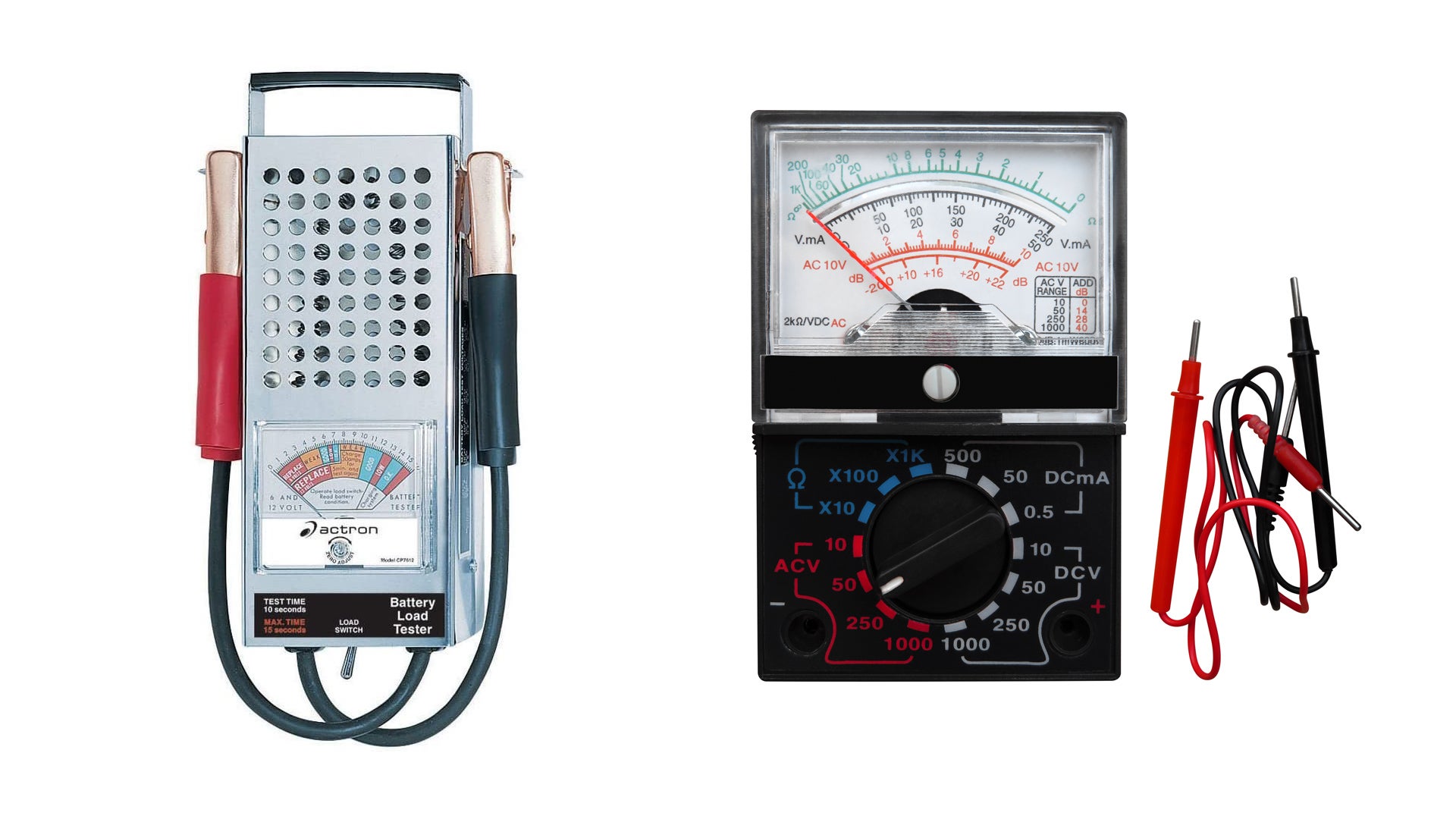Every garage should have a multimeter. Anybody can pick up a decent one for less than $40, and it can be used to test all types of electrical connections on your car. Battery? Test it. Relay? Test it. Alternator? Test it!
The process of testing a battery is pretty simple, but one look at a multimeter could send inexperienced wrenchers’ heads spinning. Don’t be intimidated, you only need to know a few quick steps to use the multimeter and check the status of your car.
The Drive’s info-obsessed editors have seen more dead batteries than a junk drawer and have charged, discharged, and jump-started enough cars to fill a museum showroom floor. We’d like to impart our years of experience and knowledge to you.
Let’s get started.
How Many Volts Should a Car Battery Have?
Your car uses a 12-volt battery, and a multimeter should read between 12.5 and 12.8 for a healthy battery.
What Causes a Car Battery to Drain?
- Time
- Extreme weather
- Poor battery connections
- Corrosion
- A short in the system
- Faulty charging system, including a bad alternator
- Something like a dome light is leeching power
How Do I Know if My Car Battery is Bad?
First, you’ll have to need to be able to identify the signs that your battery is in bad shape. Then you’ll have to test it. Below, I outline the signals that your battery might be bad.
Symptoms of a Bad Battery
- The battery light comes on.
- The battery terminals are corroded.
- The battery is physically bulging.
- Interior lights turn on but car won’t start.
- Nothing on the car works.
- The car turns on but the engine won’t turn over.
- The engine is slow to turn over.
- Your headlights are dim.

Battery Safety
Working on your car can be dangerous and messy, so here’s exactly what you’ll need to ensure you leave in the same condition in which you entered.
Everything You’ll Need To Test a Battery
If you want to precisely test the true condition of your battery at home, you’ll need the devices that can help you do the job. Here’s what you’ll need.
Tool List
- Battery charger
- Multimeter
- Battery load tester
- Ratcheting socket set
Organizing your tools and gear so everything is easily reachable will save precious minutes waiting for your handy-dandy child or four-legged helper to bring you the sandpaper or blowtorch. (You won't need a blowtorch for this job. Please don’t have your kid hand you a blowtorch—Ed.)
You’ll also need a flat workspace, such as a garage floor, driveway, or street parking. Check your local laws to make sure you’re not violating any codes when using the street because we aren’t getting your ride out of the clink.
Here’s How To Test Your Car Battery Without a Multimeter
Multimeters are extremely cheap tools that everybody can afford and should buy, but if you haven’t gotten around to it yet, there are other ways to check your battery’s health.
Use Auto Parts Stores
Most nationwide auto parts stores, such as Autozone or Advanced Auto Parts, offer free services for battery testing and charging. If you’re able to make it to the shop, it’s a great resource.
Use the Headlight Test
This is an unscientifically imperfect way to test your battery, but it can be an easy method for checking its health.
- Turn the headlights on for five to 10 minutes without turning the car on.
- Turn the car on.
- If you notice your lights significantly dim down when the car is turned on, your battery doesn’t have the right charge and might be on the way out.

Here’s How To Test Your Car Battery With a Multimeter
Let’s do this!
- Pop the hood, locate the battery, and move any terminal caps out of the way.
- Clean the terminals, if necessary.
- Turn on your multimeter and turn it to DC voltage, then 20 volts.
- Touch the black probe (negative) onto the negative (black) terminal.
- Touch the red probe (positive) onto the positive (red) terminal.
- View the reading on your multimeter display. A healthy battery should read out right around 12.6 volts.
Here’s How To Test Your Car Battery With a Load Tester
Make sure the battery is as charged as possible.
- Pop the hood, locate the battery, and move any terminal caps out of the way.
- Remove the battery cables.
- Clean the terminals, if necessary.
- Mate the positive load tester clamp to the positive terminal, they will be red.
- Mate the negative load tester clamp to the negative terminal, they will be black.
- Press the load test switch and leave it on for about 10 seconds.
- If the tester reads 9.5 volts or lower, your battery is bad and needs to be replaced.
FAQs About Car Batteries
You’ve got questions, The Drive has answers!
Q. But Will a Dead Battery Always Jump Start?
A. Assuming there is nothing wrong with the battery, it should start. However, during a time when a battery is not used, there are all sorts of issues that could arise, including corrosion that could damage the battery and cause it to short. If you have a bad battery, you wont be able to jump it, but if it’s just low on charge, it should work.
Q. Then Can a Bad Alternator Destroy a New Battery?
A. If an alternator is bad, it’s possible that it could overcharge the battery and ruin it.
Q. So How Do You Clean Battery Terminals?
A. You’ll need a wire brush and some baking soda. We go through the steps in our guide, How To Clean Battery Terminals.
Video
The Drive and its partners may earn a commission if you purchase a product through one of our links. Read more.
More From The Autance
- Let’s take a closer look at the the Senna/Prost McLaren MP4/4
- The 2022 Audi S8 is everything it should be
- Tell us, what car parts do you cheap out on?
- Can lightning actually jumpstart your car?
- Here’s what the insides of an engine with 300,000 miles look like
Got a question? Got a pro tip? Send us a note: [email protected]









